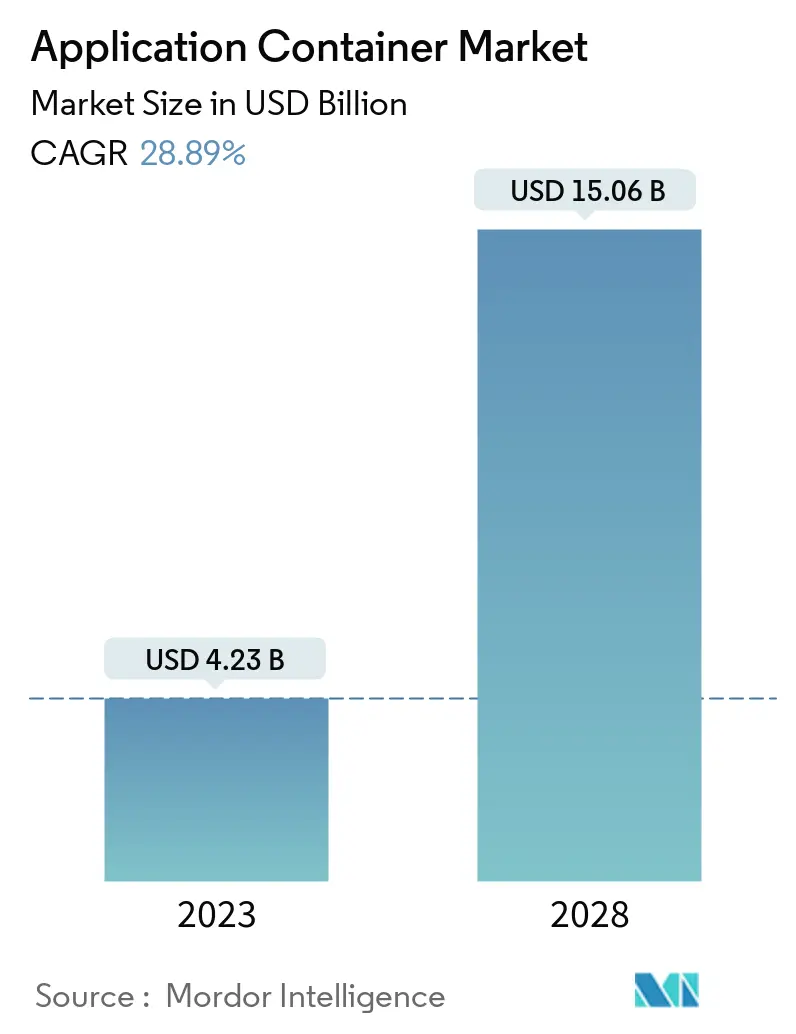Market Size of Application Container Industry

| Study Period | 2018 - 2028 |
| Market Size (2023) | USD 4.23 Billion |
| Market Size (2028) | USD 15.06 Billion |
| CAGR (2023 - 2028) | 28.89 % |
| Fastest Growing Market | Asia Pacific |
| Largest Market | North America |
Major Players
*Disclaimer: Major Players sorted in no particular order |
Need a report that reflects how COVID-19 has impacted this market and its growth?
Application Container Market Analysis
The Application Container Market size is expected to grow from USD 4.23 billion in 2023 to USD 15.06 billion by 2028, at a CAGR of 28.89% during the forecast period (2023-2028).
- As part of the digital transformation initiatives, multiple enterprises are primarily focusing on replacing their traditional, manually-based IT tasks with software that can automate the test, configuration, and runtime processes, and containers have emerged as a very critical enabling technology. Organizations can deploy faster, better, and cheaper applications by offering IT organizations a solution to break down applications into more digestible and smaller modules.
- Application Containerization has many benefits over the traditional application environment. For example, Virtual machines can run several operating systems because the hypervisor enables communication between the guest operating system and the host kernel. Still, any installed apps, which are limited to the physical hardware that has been assigned to them, are unable to communicate directly with the host kernel. In this scenario, the application containers directly connect with the host operating system kernel, and the container runtime leverages the underlying operating system, making it a much lighter option.
- Popularized by Docker Inc., the containerization of applications has recently been increasingly adopted. Many organizations are leveraging containers to modernize their legacy apps, streamline infrastructure, and to be able to market their innovations faster. Containers primarily help speed up the applications to market because they offer faster, more consistent release cycles. The application is therefore developed in a container, packaged, tested, and deployed into production. As the application is already being tested in a runtime environment, there is no need for additional testing. Also, much less troubleshooting is required as containers are built to restart when they detect a failure.
- The deployment speed of application containers makes them vulnerable to cyber security risks such as a bug that can be used against a business or a misconfiguration. Enterprises lack visibility into the locations of their mission-critical data as IT infrastructures become more heterogeneous, notably because of the deployment of containers, making them more susceptible to data loss, which is a market challenge for the adoption of application container solutions across industries.
- The COVID-19 pandemic imposed remote working scenarios, which have highlighted the importance of the cloud for business continuity with remote workforces and smooth online communication. Any enterprise's journey toward cloud transformation includes a container strategy. Numerous businesses adopted a container-first strategy because of the flexibility and cost savings that application containers provide, which is creating a demand for the market in the post-pandemic phase.
